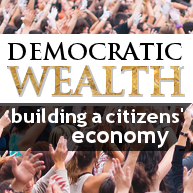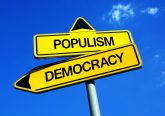 Democracy is morally prior to the economy. The structure of the economy is something a sovereign people may and should design and redesign to secure its common good – that is, the shared interest of each and every citizen in life, liberty and economic opportunity. This is the basic premise of the ‘Democratic Wealth’ series that I have the pleasure of editing.
Democracy is morally prior to the economy. The structure of the economy is something a sovereign people may and should design and redesign to secure its common good – that is, the shared interest of each and every citizen in life, liberty and economic opportunity. This is the basic premise of the ‘Democratic Wealth’ series that I have the pleasure of editing.
This is, however, by no means an uncontroversial premise.
There is, for example, a tradition of libertarian thought which argues that people (can) establish moral rights to highly unequal amounts of private property and income in a state of nature. This view is defended by Robert Nozick in his famous 1974 book Anarchy, State and Utopia. The rights in question are held to set strict moral limits on the democratic co-authorship of the economy. Because of these supposed rights, a free-market economy, or something close to it, is held to have moral priority over democracy.
So the philosophical choice has often been posed as one between democracy or private property rights.
Very recently, however, a new school of free-market thought has begun to emerge which rejects this as a false choice. John Tomasi’s recent book, Free Market Fairness, accepts that the economy is fundamentally subject to democratic authority. Economic arrangements must be justifiable in a democratic deliberation to those citizens who have to live with them. However, Tomasi argues, the common good of a sovereign people is best served by (something reasonably close to) a free-market economy.
‘Left liberals’, such as John Rawls, and socialists, have allegedly missed this because they have underestimated the importance of ‘economic liberty’ to individual citizens. Correct that mistake, Tomasi argues, and we have good reason to suppose that a democratic people may and should will something like a free-market economy – because it is uniquely the kind of economy which respects their economic liberty. To will it securely, they should will it constitutionally, giving economic liberty the same constitutional protection that liberals generally wish to give other freedoms (e.g., of speech and conscience).
Tomasi’s thesis is an audacious one. Unsurprisingly, it is stimulating a lot of debate. In May 2012, Tomasi published an article summarising his argument in the ippr journal, Juncture, with supporting video. I blogged a response to Tomasi’s article.
In the article below, republished with kind permission of the Boston Review, Thad Williamson and Martin O’Neill offer another response to Tomasi’s book. They argue that a democratic people committed to its common good may and should reject the free-market economy in favour of something more egalitarian.
—————————————————————————————————————————————
Free Market Fairness: a review
By Martin O’Neill and Thad Williamson, originally published in the Boston Review.
Free Market Fairness, John Tomasi, Princeton University Press.
If you call yourself a libertarian, there may be no two scarier words in the English language than social justice.
There are many ways to look at social justice, but it is generally understood as demanding that institutions and social practices promote the flourishing of each and all and prevent the domination of any one group by another. This view of justice is inconsistent with the libertarian claim that some people haveabsolute rights to property, rights that cannot be overridden even by others’ needs for the share of resources that would allow them to have a decent life. That claim also holds that property owners are unconditionally justified in excluding others from using their property, beyond the taxation needed to sustain a minimal state.
This position—associated most famously with Robert Nozick—denies the basic requirement of justice: that individuals (and their families) enjoy a decent or equitable share of resources, social esteem, or opportunities to develop their own capabilities—a share sufficient to make it reasonable for them to endorse the social order. It’s too bad that some people are unlucky, but property rights can’t be violated in order to improve their situation.
Because Nozick was an effective writer who produced many interesting thought experiments, and because he showed the impossibility of combining a free market with strict equality of outcomes, he has remained a staple in the debate about justice. But he is often used as a punching bag, to illustrate why strong libertarian views are not properly conceptions of justice at all, but are instead rationalizations for the exclusion of the many and the domination of the property- owning few.
Political philosopher John Tomasi’s Free Market Fairness is a carefully crafted attempt to provide what has long been missing from the debate: a non-egalitarian, non-utilitarian, and non-aristocratic conception of social justice thatis recognizably a conception of social justice. Tomasi rejects strict libertarian views that identify absolute property rights with absolute rights of individual self-ownership. Instead, he aims to revive the classical liberalism of F. A. Hayek and Milton Friedman and to bring it into conversation with John Rawls’s idea of a just society, a society whose political and economic arrangements are acceptable and justifiable to each of its members.
The book is written in a friendly, relaxed tone that seeks to build bridges in two directions. First, Tomasi aims to convince the libertarian-minded that they needn’t be hostile to the idea of social justice. He emphasizes that leading classical liberals and libertarians—even Ayn Rand—have implicitly or explicitly invoked something like the Rawlsian idea that the social system ought to work to everyone’s benefit. Tomasi himself endorses this basic Rawlsian claim and argues that Hayek’s critique of social justice does not undermine the core of Rawls’s project.
Second, Tomasi seeks to persuade liberal egalitarians in the Rawlsian mode—those he terms “high liberals”—that their thinking fails to recognize the moral significance of “economic liberties.” He believes that this failure in turn bends liberal egalitarian thought toward an excessively critical assessment of capitalism. Tomasi’s proposed alternative view—“market democracy”—endorses “enthusiastically capitalistic” institutions as the best way not only to respect political and economic liberties, but also to achieve a just society. In practical terms, this may mean using taxation to assure access to key public goods such as education, health care, and a minimum income, but it also means abandoning “material egalitarianism” and, whenever possible, seeking non-statist ways to achieve social goals. While market democracy does aim to lift the income of the least well off over time, Tomasi argues that the best way to achieve this is to permit large-scale inequalities and as free a market as feasible.
But while Tomasi’s critique of egalitarianism and trenchant defense of capitalism enrich the classical liberal position and extend the debate on what constitutes justice, ultimately they don’t hold up.
• • •
Rawls’s theory of justice contains two principles. The first requires a scheme of basic liberties to be enjoyed and exercised by each and all. The second requires substantive equality, combining fair equality of opportunity with limitations on inequality so as to maximize the position of the least well off group. The first principle is prior to the second.
At the heart of Tomasi’s revival of classical liberalism is the claim that economic liberties ought to be considered basic in the same sense that political liberties are in the Rawlsian scheme. Basic liberties are not absolute; they can be legitimately curtailed to protect other basic liberties or to ensure that everyone can exercise them. But a high moral value is attached to basic liberties; proposals for limiting them must reach a very high justificatory standard. As Tomasi observes, Rawls’s account of basic liberties denies that special status to economic rights, such as a right to free commerce and a right to hold productive property. Instead, basic liberties for Rawls consist only in civic and political freedoms, such as a right to equal political voice, and personal freedoms, such as freedoms of movement and occupational choice and freedom to hold personal property.
Is there such a thing as a libertarian conception of social justice?
For Tomasi economic liberties appear to include a right to hold productive property; a right to engage in commercial contracts in one’s interest, including a right to sell one’s own labor on one’s own terms; a right to make one’s own decisions about savings and long-term financial planning; and, in general, a right to benefit from one’s own economic activity. If these liberties are recognized as basic, then even within a Rawlsian scheme they cannot be overridden for the sake of promoting the secondary principle of equality.
Tomasi’s support of economic liberties is not rooted in libertarian claims about self-ownership, taxation as theft, or the unjustifiability of regulating market transactions. At various points, he recognizes the legitimacy of all four common justifications of market regulation: to protect workers from exploitation, to protect consumers, to protect third parties harmed by market transactions (through externalities), and to preserve the stability of the economy or society as a whole (e.g., through regulation of the financial sector).
Instead, Tomasi’s case for the economic liberties is rooted in two moral claims. The first is that free economic activity is both a fundamental expression of human freedom and, more powerfully, a fundamental mechanism for self-realization. He frequently returns to the example of Amy’s Pup-in-the-Tub, a small business outside Providence, Rhode Island catering to the bathing and grooming needs of pets. On Tomasi’s account, Amy invested not only her money but also her time and effort to make the store a reality, knowing that prospects for success were uncertain. Consequently, she can take great pride and satisfaction in her business. She has made her own life through her economic activity.
Free Market Fairness is largely innocent of serious empirical inquiry into market societies and how they work, but there is in fact strong empirical support for the story about Amy. Robert Lane’s landmark 1991 book The Market Experience concludes that a primary benefit of markets is the sense of accomplishment they confer on many people—including not only entrepreneurs such as Amy, but also many employees. Tomasi’s view is that high liberals often undervalue the moral significance of such satisfaction. He thinks that progressive political theorists, lacking experience in the entrepreneurial world themselves, have a bias toward political liberties. If they looked at the world through Amy’s eyes—or even for a time, tried to follow in her footsteps—perhaps they’d have a healthier appreciation for economic liberties.
Tomasi’s second moral claim depends upon the long-term effect of capitalism. Capitalism, he points out, has produced enormous economic growth and increased living standards in the developed nations. Continued economic growth is the surest recipe for further enhancing the prospects of the working class and the poor, who have already benefited. Hence we have a moral obligation to pursue capitalist growth. Tomasi criticizes Rawls for implying that a no-growth economy could make for a just society.
• • •
Tomasi makes important arguments for both of his moral claims, but neither is persuasive. Let’s start with Amy and the benefit of working and achieving for oneself.
Amy’s story proves far less than Tomasi suggests. If he simply means that a just society should accept and promote the basic right of individuals to control productive property, such as a small business, then high liberals can agree. Protection of a general right to operate a small business is consistent with a Rawlsian property-owning democracy. It is true that Rawls did not argue for a citizen’s basic liberty to own productive resources; he believed that justice could be achieved under different regimes of property-ownership, whether fundamentally capitalist or socialist in nature. But ensuring broad access tocontrol over productive resources is a central demand of his view of social justice. Amy could take satisfaction in the success of her Pup-in-the-Tub in a Rawlsian society, just as much as she does in Tomasi’s free market world.
Amy is a curious example not only because her activities are protected in Rawls’s framework, but also because her business represents a small and threatened sector of modern capitalist economies. The dominant form of economic organization today is not the small business but the large-scale corporation, which is itself a creature of the state. Should there be a general presumption in favor of corporations’ rights to engage in free contracting, and if so, should this be enshrined as a basic liberty? Tomasi doesn’t say, but it is clear that defending a right for Amy to own and operate a business need not entail that corporations have a strong right to minimal regulation.
Emphasizing individual economic liberties obscures the question of who sets the choices available to ordinary workers.
The Amy story is also misleading because it privileges the experience of the small business owner. What about the worker in a large-scale firm? Blue-collar workers in industrial enterprises also take satisfaction in their economic accomplishments and their ability to make a life for themselves, their families, and their communities through their own efforts. Tomasi faults leftist political theorists for being insufficiently familiar with or sympathetic to Amy’s experiences, but there is little in Free Market Fairness to suggest that Tomasi is familiar with or sympathetic to the moral experiences of ordinary workers. And he evinces even less recognition of the ways in which corporations destroy working-class communities through plant closures, wage cuts, and poor working conditions.
Historically, collective bargaining is one of the principal vehicles through which workers have got hold of a piece of the capitalist pie for themselves, so shouldn’t there be a basic right to organize in the workplace? Acknowledging such a right would immediately conflict with Tomasi’s commitment to enshrining a basic right of individuals to negotiate their own labor contracts: union contracts are toothless if they do not cover everyone working for a firm. And a right to organize would raise thorny questions about how to handle conflicts between the claims of people such as Amy and the claims of workers who wish to bargain collectively.
Another conflict arises between Amy’s claims and interests and those of much larger economic entities, such as Walmart. Walmart’s expansion across continents has ruined the lives and accomplishments of many independent business owners. If Amy and people like her are exemplars of the moral good that can come from markets, then there needs to be regulation and intervention to prevent them being systematically put out of work by much larger companies that can afford to underprice local markets. Far from natural companions, the moral value of capitalist endeavor and the demand for deregulated markets stand in opposition.
Thus Tomasi seems transfixed by an attractive but unrealistic picture of self-realizing producers exercising their economic liberties to carve out a place for themselves in the world. This is rarely what we get when we have deregulated markets. Indeed it is more readily consistent with the high liberal accounts of social justice with which Tomasi takes himself to be in disagreement. Tomasi wants to promote his classical liberal vision of economic organization, but the force of his underlying moral vision pushes in an entirely different direction.
Any scheme to regulate the employment relationship or the relationship between smaller and much larger firms in the market would necessarily involve a thicket of complex issues and practical judgments. We suspect this is one reason why Rawls thought it wisest to exclude economic liberties from the list of basic liberties. Rawls was aware of the moral value of independent economic activity, but he thought that legislatures concerned to make sensible social policy were the proper places to work out the balance between economic rights and other competing interests. Likewise, since the goods that market society can provide—satisfaction, a sense of achievement—are obtained through multiple institutional mechanisms (some individual, some collective), there is a strong case against morally privileging the liberty of the small business owner.
• • •
What of Tomasi’s second claim, that capitalism has raised the standard of living for workers and even the (relatively) poor? Laborers in developing nations—exploited for the gain of the developed world, sometimes in conditions of near-slavery—might reasonably object, but the claim can also be challenged within a domestic frame in at least three ways.
First, in the United States, these economic gains were secured while the public sector was growing dramatically. In 1930 federal spending was 3.4 percent of GDP. In 2008 it was nearly 21 percent. Labor laws effectively encouraged unionization from the mid-1930s until the Reagan years, the welfare state emerged alongside a fairly progressive tax code, and government played a major role in developing critical new technologies such as modern airplanes and the computer. There is good reason to think these changes helped to stabilize capitalism against frequent downturns and depressions and that they improved the lot of the working class. American economic growth should not be attributed to capitalism in any pure sense, but to a mixed economy that includes a heavy dose of public sector activity and economic regulation.
Second, as unions have declined—and not, a Tomasi claims, for lack of worker interest, but because of aggressive anti-labor tactics—and corporate political spending has risen, economic progress for the working class and poor in the United States has essentially stalled. Since the mid-1970s, hourly compensation for the median worker has grown just 10 percent, even though workers are 80 percent more productive today than they were in 1975. The official poverty rate, after falling by half in the 1960s, is now higher than it was in the early 1970s. Economic security and workplace conditions are worsening, especially among those without a college degree. And inequality has grown rapidly: the top 10 percent claimed 100 percent of total family income growth between 1970 and 2008, and the top 1 percent alone claimed more than half of the gains between 1993 and 2010.
It is doubtful that market policies maximize the wealth of the least fortunate.
Market societies—even when they generate economic growth—do not automatically lead to continual improvements in economic well-being for the bottom half (or even the bottom 90 percent) of the population. Capitalism has worked as well as it has for the less well off precisely because of effective regulations and laws that prevent corporations and the wealthy from excessively tipping the rules of the game in their own favor. As government’s capacity to constrain corporations and the wealthy has declined, so has the economic well-being of workers.
Third, even if everyone were benefiting from economic growth, there would be reason to doubt that indefinite growth leads to indefinite improvement in human well-being. After achieving a baseline of economic security, most people don’t find themselves happier thanks to higher incomes. What they want instead is more time for friends, families, and activities that give their lives meaning. As Lane shows in The Loss of Happiness in Market Democracies (2000), many people in the developed countries sacrifice their own happiness and friendships for greater income.
Perhaps all these people are freely choosing to overwork. But this is improbable. The more likely explanation is that many workers can’t earn enough unless they’re overworked. Because firms don’t have much incentive to offer generous terms, workers are effectively not free to find a 30-hour workweek, adequate salary, and flexible scheduling. An emphasis on individual economic liberties obscures the question of who sets the menu of choices available to ordinary workers. As societies get wealthier in goods but poorer in time, there are compelling reasons of both social justice and social rationality to restructure markets and employment rules so that ordinary workers can more easily choose time over pay.
Tomasi rejects the claim that caring about social justice requires aiming for substantive distributive equality. To assess market societies, he invokes a much weaker standard of “distributional adequacy”: each and all should benefit from political and economic arrangements; if all are better off, it is acceptable that some have much more than others. In stark contrast to Tomasi’s view, Robert Frank, in his 2011 book The Darwin Economy,persuasively shows why a concern for the well-being of all should lead us to worry about income and wealth inequality, even if society meets a baseline of distributional adequacy, which currently it does not.
To make his case, Frank calls attention to “positional goods,” which are inherently scarce. These include front-row seats at Los Angeles Lakers games, beachfront property, real estate near Central Park, admissions to elite private universities, and having a bigger house than one’s neighbors. It is the scarcity of these goods that makes them so relevant to discussions of justice.
In the context of moderate inequality, no one will be able to monopolize all these different goods. Some people will have the means to buy the best tickets to Laker games, and some the best beachfront property, but no one will have the means to buy up all such goods. But in a context of unlimited inequality, the very rich will be able to monopolize these scarce goods—including those that are not top personal priorities. Passionate basketball fans who live and breathe the Lakers but have only ordinary incomes have no hope of sitting near the court (many will be lucky to get in the arena on a regular basis in the first place). They will be displaced not only by equally passionate but richer fans, but also by casual ones. Runaway inequality is not a neutral fact: it harms those priced out of valued positional goods, undermining their ability to pursue their own interests and preferences.
Frank points out how extreme inequality also creates socially irrational expenditure. Because people are concerned with rank and status, they have an interest in having a large relative share of the goods that indicate high status, even if having a large share isn’t useful. His favored example is housing size. People don’t want just a house big enough to meet their needs and wants; they want a house that is bigger than most other people’s. As the very rich acquire more and more money, they build bigger and bigger houses. This in turn puts status pressure on the income groups below them, who also build bigger houses. At least at the top end, though, it’s doubtful that bigger houses make their occupants happier or better off. The person who builds a $6 million home to keep up with his neighbor’s $5 million home would likely have been just as satisfied if he were in a $3 million home while his neighbor was in a $2.5 million home.
Those millions of dollars being spent on fancier homes that don’t make people happier could have produced a lot more social benefit if they had been transferred to poor, working-class, and middle-class people who have been evicted from their homes after defaulting on their mortgages. Clearly the existing political economy is not actually working to the benefit of all.
Tomasi tries to deflect worries about capitalism in practice by claiming the high ground of ideal theory: the philosophical choice between free market fairness and its alternatives ultimately rests not on empirical and feasibility concerns, but rather on which vision of justice is most compelling at a moral level. This conception of the task of political philosophy is questionable, but more important here is that Tomasi’s claim that free market fairness is morally superior rests strongly on the dubious empirical assertion that free market policies will “maximize the real bundle of wealth and income that the least fortunate among us personally controls.”
• • •
Rawls’s arguments for a property-owning democracy can accommodate at least the more plausible portion of Tomasi’s concerns. The wide disbursement of capital can not only help to correct the undue political influence of giant corporations and the rich, but it can also create a society in which there are more Amy’s Pup-in-the-Tubs and more people have enough to make their own way in the world without being dependent simply on labor income or constrained by the circumstances of birth.
Tomasi is right that a just society should permit the private control of productive capital, but his further claim that this should lead us to embrace deregulated capitalism is wrong. The moral goods of exercising freedom through market activities would be more widely realized under a regime of Rawlsian property-owning democracy than under the sort of minimally regulated capitalism that Tomasi celebrates.
This piece is part of the Democratic Wealth series, hosted by Politics in Spires in partnership with OurKingdom.










No Comment